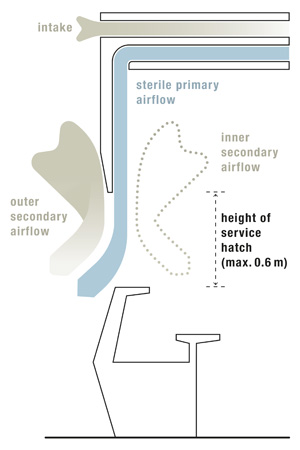Sushi used to be an exotic snack, but today the rice rolls have become a standard culinary offering in pedestrian zones, shopping malls and train station food courts. The Japanese delicacy is popular for many reasons: it’s low in calories and fat, tastes good and is filling. Fresh ingredients are essential, which is why sushi chefs prepare it before the eyes of their customers. What most of the customers don’t know is that there’s an invisible wall between them and the kitchen. An air curtain that keeps germs away from food is legally required where food is served fresh: at sausage and cheese counters and also at sushi bars.
“Sushi stands are very small. They don’t need units that are designed for ten-meter-long counters.”
Frank Vorwerk, Technical Director at HANSA
HANSA Klimasysteme GmbH specializes in such air curtain systems and supplies them in various sizes. “Our system was patented many years ago, and we’ve gradually perfected it,” says Frank Vorwerk, Technical Director at HANSA. So he was well prepared when a supplier for sushi stands was looking for an especially compact system. “These stands are very small. They don’t need units that are designed for ten-meter-long counters. So we developed an especially compact version of our LF-Hy series.”
A wall of air
In the unit, a fan draws air into a two-stage filter system that keeps dirt and germs out of the customer area. The nearly sterile air is routed through a duct system to a ventilation slot in the ceiling. “The aerodynamic design of this slot is crucial for directing the air curtain and keeping it stable. The air can’t be allowed to get into contact with the food since it would dry out. And we want to achieve a closed air curtain with as little air flow as possible,” says Vorwerk.
Since the unit runs constantly, low energy costs were a key requirement, so HANSA needed a powerful and — because of the pressure drop caused by the two filter stages — adjustable fan that also consumes little electricity. “We decided on an EC centrifugal fan from ebm-papst. It performed best in our development tests, and we’ve been working with the company for many years.”
How the hygienic air curtain works
HANSA’s LF-Hy series of air curtains works according to the following principle:
The fan draws in air from the customer area. First the air passes through a prefilter that removes dirt.
Then the fan forces the precleaned air through a germ filter like the ones in operating rooms.
The nearly sterile air is routed through a duct system to a ventilation slot in the ceiling.
The aerodynamic design of the ventilation slot ensures that the air flows back into the customer area as a stable layer along the glass skirting through the counter opening.


Leave a comment